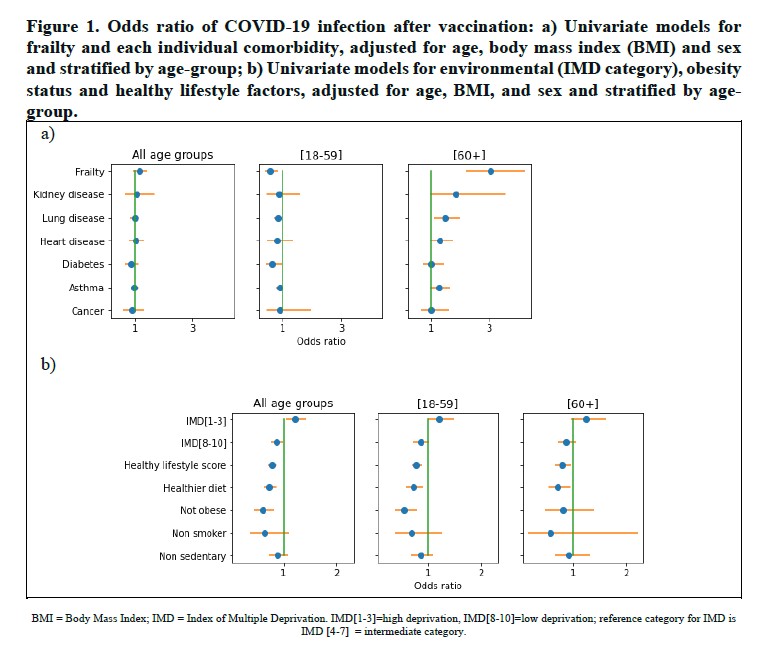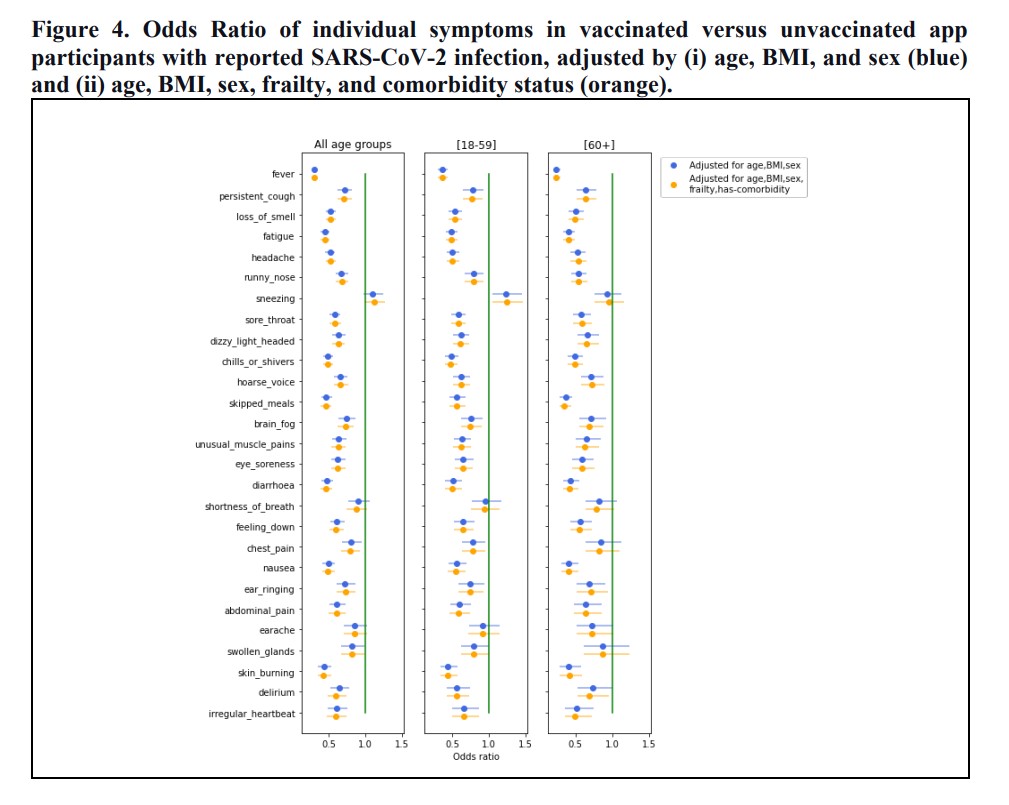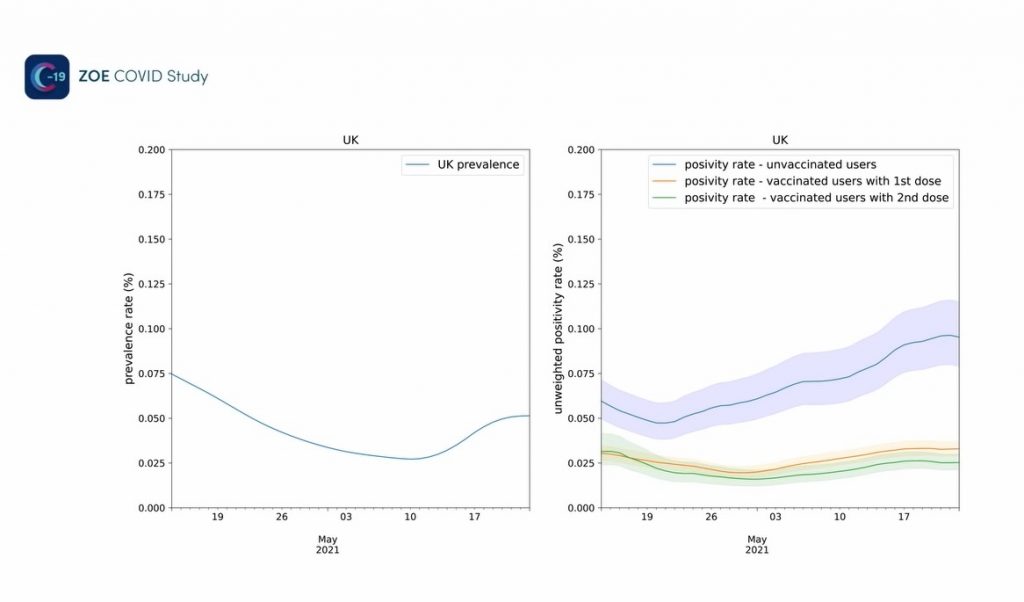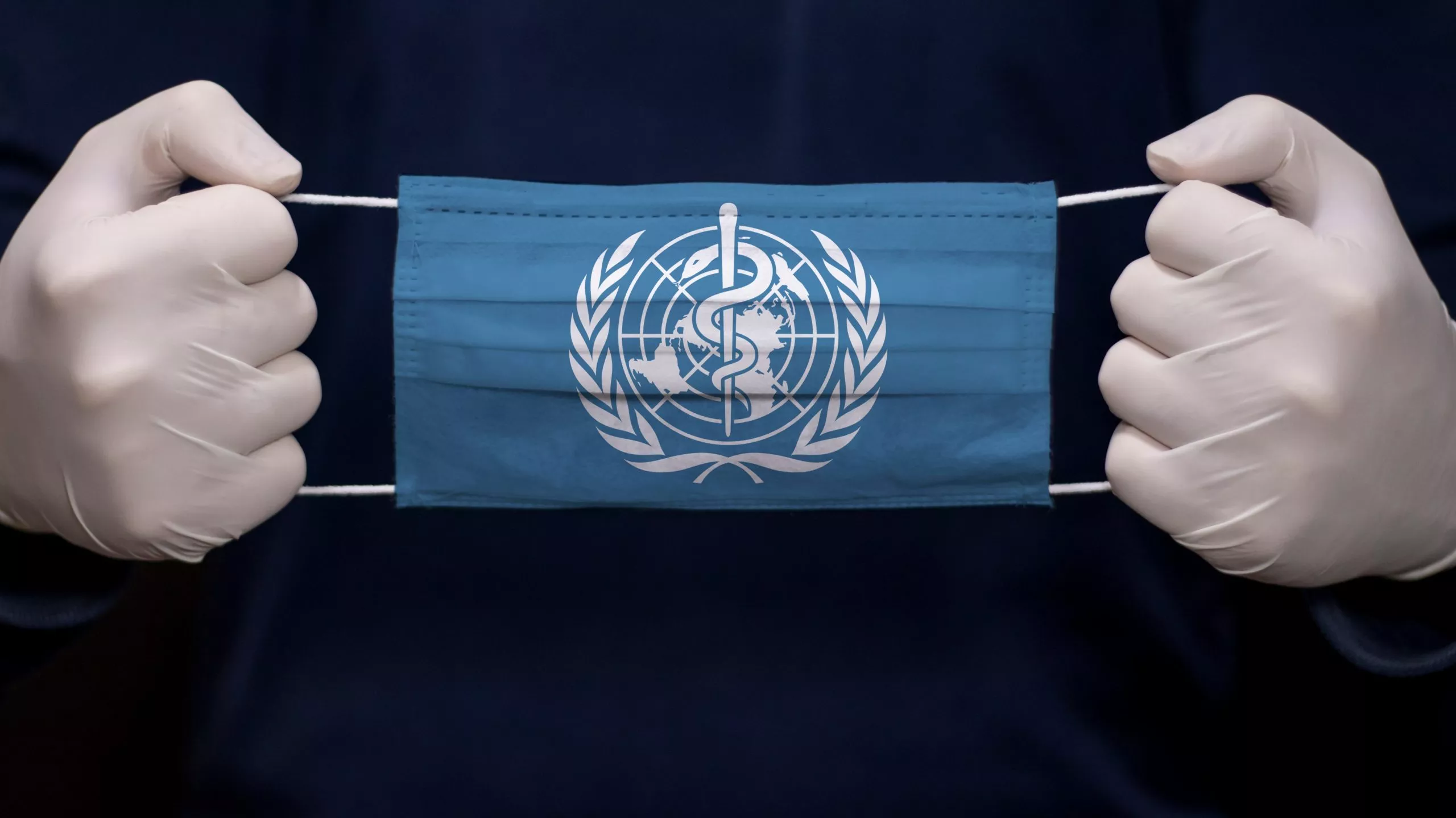Professor Tim Spector, who leads the ZOE Covid Symptom Study, has done a new video update on vaccines, which is worth a watch. The team has also published a new study (not yet peer-reviewed) about the vaccines and their effect on symptomatic Covid.
The data is broadly encouraging in terms of efficacy. (They don’t address safety, though a previous study did. They also exclude the period immediately after each vaccine dose, so the study tells us nothing about any post-jab spike in infections, which is disappointing.)
One interesting finding is that sneezing becomes more common as a symptom of Covid infection after vaccination than beforehand, which the authors suggest could be a result of our immune system reaction changing. They note this could make the disease more infectious owing to the additional aerosols produced.
A concerning finding was that the elderly (over-60s) were up to three (2.78) times more likely to be infected after being vaccinated (with one dose of any vaccine) if they were frail than if they weren’t. This is unsurprising perhaps, but still indicative of considerably lower protection for those already at higher risk from the disease. Furthermore, a quarter of the vaccinated frail elderly in the study who contracted the virus ended up in hospital, which is not a small proportion (though no figure was given for the hospitalisation rate of unvaccinated frail elderly people against which to compare it).
Vaccine efficacy was also reduced in the obese, another high risk group, and those with an unhealthy diet – see charts below. The baselines are people who are also vaccinated and otherwise similar, but without the particular characteristic mentioned, e.g. the point in the top right shows the additional risk of infection that the vaccinated frail elderly have versus the vaccinated non-frail elderly.

The authors note this means the vaccinated high risk, especially the frail elderly, are still susceptible to infection and serious disease. However, they did find that vaccination cut the general risk of hospital admission by 64% and increased the chance of being asymptomatic by 72% once infected. Infections in vaccinated people were also around half as likely to have more than five different symptoms. Similarly, in infections in vaccinated people, most symptoms were around half as likely to appear (see chart below).

A graph shown as part of this week’s video also gives us a glimpse into the vaccines working almost in real time.

The positivity rate for the unvaccinated here peaks around 0.095% while for the fully vaccinated it peaks around 0.025%. It’s tempting to estimate vaccine effectiveness from those figures (74%) but actually we can’t do that because the data is unweighted, so doesn’t take into account, for instance, that the vaccinated are generally older and the infection rate in older people is usually lower so the vaccine effectiveness would be overestimated. At such low prevalence, false positives also become a big problem, leading to vaccine effectiveness likely being underestimated due to a higher proportion of the infections in vaccinated people being false positives.
Nonetheless, the curves are at least the right way round, with infections in the vaccinated not rising anywhere near as much as those in the unvaccinated in the recent small hump.
This is relative risk, of course. Absolute risk when prevalence is this low is miniscule.
I confess I was rather hoping that the ZOE data would shed a bit more light on vaccine effectiveness than it has done to date. The team have done one study looking at effectiveness in terms of preventing infection, but only after one dose, and like so many of these studies it is confounded by the declining background prevalence so does not give a reliable estimate of vaccine effectiveness.
Which is frustrating because I still don’t feel I can point to a study and say there, that gives a really reliable estimate of how well the vaccines work. There are lots of tantalising hints the vaccines are working well, in terms of preventing infection and serious disease (safety is a separate matter). But it’s not clear exactly how well, once you take out the fact that infections decline anyway. The effectiveness in the high-risk frail elderly also continues to give signs of being lower than we might have hoped given how susceptible they are to the virus.
As Peter Doshi wrote in the BMJ in January – more data please.










To join in with the discussion please make a donation to The Daily Sceptic.
Profanity and abuse will be removed and may lead to a permanent ban.
“Though data on frail elderly is less positive.” You mean, they were dropping like flies.
Yes. Have SAGE and co. actually said what their backup plan is if vaccines turn out not to be the way out of this? (And have they condescended to tell us yet how many people have died within four weeks of a “vaccination”?).
Those are precisely the most pertinent questions
Lockdowns and more vaccines
When this madness started it seemed to me that the very people most in danger from c19 would be those least likely to benefit/most in danger from any vaccine
I think our only chance of survival is to stay away from NHS and injections
Well – in actuality, they don’t show any faith in it, despite all the pre-release advertising, do they?
I suppose “frail” is precisely defined somewhere, otherwise using it as an unspecified qualifier doesn’t tell us a lot.
Has anyone here got graph fatigue?…
see also:
https://omny.fm/shows/on-point-with-alex-pierson/new-peer-reviewed-study-on-covid-19-vaccines-sugge
New peer reviewed study on COVID-19 vaccines suggests why heart inflammation, blood clots and other dangerous side effects occur
But medical science racing to the rescue:
https://www.bbc.com/news/health-57260463
And here’s what “experimental vaccine” means:
“No major safety warnings, other than rare cases of anaphylaxis, were reported in the initial trials, which involved tens of thousands of adults, and the risk of serious adverse effects has remained remarkably low after vaccination of more than 400 million people worldwide to date. It is not surprising, however, that new reports of adverse events have emerged as many additional people are vaccinated and follow-up is extended.
https://www.nejm.org/doi/full/10.1056/NEJMe2106315
That’s 64% of whatever the hospitalisation risk is…can’t remember… Low!
Frail elderly were not included in the ongoing trials so there was NO safety or efficacy data in this group. And yet who were the first to be given the experimental biologicals….the frail elderly. Well we know how that ended, although the MSM managed to play this down. Did anyone read anything in MSM that expressed concerns. No, I didn’t think so.
Yes, that was an early proof of the ruthless nature of the vaccine agenda. The precautionary principle was thrown out, and the core belief clearly was: “We don’t care if we kill them.”
So it seems the vaccine doesn’t work very well for those who are more likely to get seriously ill with covid. Brilliant.
… or are already terminally ill from something other than Covid?
Doesn’t work very well for those who are less likely to get seriously ill either, in fact it is more likely to damage them
If you listen to Robert F Kennedy recent speech for the Greater Reset he states evidence that the Pfizer gene therapy is 19% effective.
Sounds optimistic to me.
Sneezing increases? As the pollen count has been increasing, Correlation or causation?
Summer cold? It’s a coronavirus after all!
These people really need a Professor of State the Bloody Obvious on their teams, before submitting papers
IS IVERMECTIN THE NEW PENICILLIN?
Ivermectin, an anti-parasitic drug placed the same radioactive category as Hydroxychloroquine (HCQ) for the treatment of COVID-19, has reemerged as a promising treatment in the battle to extinguish the pandemic.
New York Times best-selling author Michael Capuzzo has called it the “drug that cracked Covid,” writing that there are “hundreds of thousands, actually millions, of people around the world, from Uttar Pradesh in India to Peru to Brazil, who are living and not dying.”
https://www.zerohedge.com/covid-19/ivermectin-new-penicillin
HCQ, Ivermectin etc were only damned by the MSM et al because they were being advocated by Trump. Now he’s gone, there’s a good chance that they will be rehabilitated.
I wouldn’t be so optimistic. Trump was possibly one pretext used to attack them, but the real reason is to protect vested interests, big pharma, dodgy deals, government narratives
We are building up to another lockdown as the summer holidays start. There is so much information on these tests and they futility to show any live infection, that I wonder at the the public still believing them. The gaslighting now becoming an everyday government policy is surely going to hit the public very hard when they realise this whole farce has purely been to reset the global economy in favour of the Bankers and large corporations. The depopulation of continents in order to keep those Bankers and Corporations in luxury and control will be the next shock to many. By which time it will be too late to turn back.
A great pity that more people with a strong platform couldn’t have collectively supported the truth and pushed the counter argument. The politicians have let us down very badly.
The last para sums it up well. Not much real evidence on the positive side compared with normal seasonal effects, and nothing said on the negative about the real risks created by the manufacturers of the products on offer. And of course, complete avoidance of any discussion as to the efficacy of the ‘lockdown’ policy at all!
Positivity rate for unvaccinated at 0.095% is about one in 1000. For the vaccinated it is about one in 4000.
It is pitiful! It is hard to understand the exuberance of the pro-vaccine proponents with pitiful numbers like this.
Would you buy a car from someone if told you will have a breakdown once in 4000 miles rather than once in 1000 miles? True, I can drive a bit further in the vaccinated car before a breakdown, but why does the vaccinated car have to breakdown at all?
Poor old William – he’s busting a gut to put a positive gloss on the snake oil.
Trouble is – there is only crap data based on observational speculation rather than proper blinded RCT data. And it doesn’t actually look good.
In scientific terms – the Big Pharma PR rush to execution has buggered itself – it doesn’t need ‘anti-vaxxers’ (i.e. critical thinkers) to do it for these 1% concoctions
FFS let’s put this in plain English shall we. If you are elderly and frail and NEED the vaccine, it’s shite. If you are younger and healthy and DON’T NEED the vaccine it helps turn a slight cold into a slighter cold! Nutshell!
… and then there’s the little matter of the fact that you are being conned if you think this snake-oil has been sufficiently tested by any criteria.
And if it’s so great – why the need to conceal its experimental nature and emerging dodgy safety record – and the ARR figures? Smells a bit ratty, doesn’t it, particularly given the basis of massive procurement prior to any knowledge, and the need to protect manufacturers with indemnity?
We’ve seen it all before with Swine ‘Flu – although that time the cards up the sleeve were sussed.
Could it just be that “the frail and elderly” are not protected by the vaccines because they are having the temerity to die of something else, but are testing positive for C19 at their demise?
The Conservative Woman‘s demolition of Cummings is one of the best I’ve seen :
“… the conception of Cummings as an otherworldly intelligence has been replaced by a portrait of a weak-minded fanatic.”
The only correction I’d make is the ‘replacement‘ notion. All of us with a brain knew that he was a dangerous simpleton with an inflated ego a long time ago.
Sorry – this got into the wrong thread. (It should have been Round Up).
So the vaccines fail properly to protect the very group they were intended to. Brilliant. And then the kicker:
Precisely. Now can all the chickens stop running around and put their heads back on? Pleeease?
Newsflash: frail elderly people die. Christ, that’s a real shocker. Who knew. So perhaps instead of obsessing with vaccination, we could make the last months of the frail elderly a pleasant experience by making sure they are loved and cared for and visited and given company when they want it and allowed outings when they feel up to it. Revolutionary I know but perhaps treating the frail elderly like human beings rather than like points on a graph that might make Covid stats look bad would be a start. Why on earth is it worse for a frail elderly person to die of Covid than die of dementia, or cancer, or heart failure or kidney failure or just plain old age. Except that obviously it is worse now because the ends of their lives have been made so much worse than they were.
So, the vaccinated are likely to be more infectious because they are sneezing everywhere, but are not sick enough to be at home under the covers? And when the old and frail get vaccinated it doesn’t stop them from getting the disease and dying from it? In fact, it makes them more likely to get sick and die? And there are no conclusive data on the immediate effects of the vaccine?
Yet we’re being guilt tripped into getting vaccinated to protect others?
I’m starting to think that vaccinated people are more dangerous to me than I am to them and that the solution of vaccinating everyone will not prevent those most at risk from dying at all. As scary as some of the rhetoric is (asking what the “Final Solution” to the “Unvaccinated Question” is), I’m prepared to wait this one out. I think there’s going to be a backlash against the medical/political technocracy like they’ve never seen when this blows up in their faces. If this turns out to be as bad as I think it will be, then it’s possible that some very powerful people are going to hang for what they’ve tried to do here.
All we can do is try to stop as many kids from being vaccinated as possible. It’s a sad indictment of our society that we’re prepared to genetically experiment on children in this way. Shows that maybe we are beyond saving.
The Torygraph reports that the fat cowardly non-scientist is going to decide on assaulting children with the experimental cr@p. Wonderful.
And we know what Toad will do. First he will bluster and bang the table and say it’s not necessary. And then Vallance and Ferguson will come in and say: “Now Toad, a new variant has come along and if you don’t do as we say, thousands of children will die of Covid and you will never be elected again.”
And Toad will sniff and say: “If I must.” and then appear on television looking dishevelled and grave and telling parents tis their duty to bring their children in so that their innocent cells can manufacture Chinese spike protein and send it out into their fresh young bloodstreams.
Toad will almost weep as he requires the parents to make “one more sacrifice to get us through this”.
For Toad has no principles.
They also exclude the period immediately after each vaccine dose.
Mission accomplished then.
We’re told that the vaccination doesn’t stop people catching or spreading the virus, it just (allegedly) makes a person less likely to suffer serious symptoms. We’re also told that asymptomatic people still spread the virus. So, taking these points as truth, a vaccinated person is more likely to infect someone than is an unvaccinated person because the vaccinated person is likely to be asymptomatic and wander around infecting everyone (s)he encounters, whilst the unvaccinated, symptomatic, person is likely to self isolate.
Alternatively, it’s all lies.